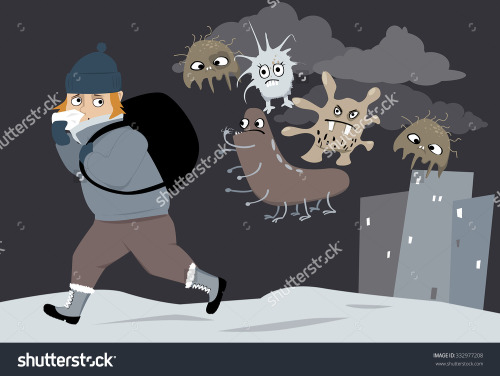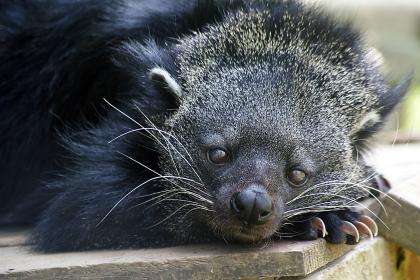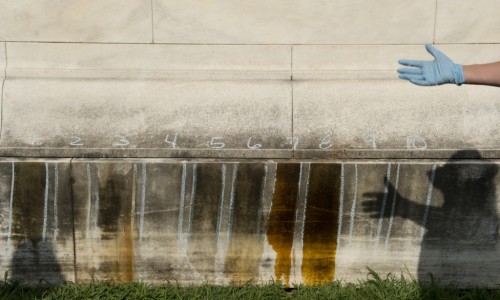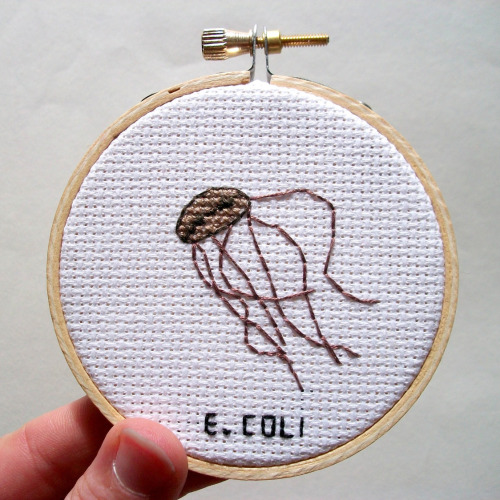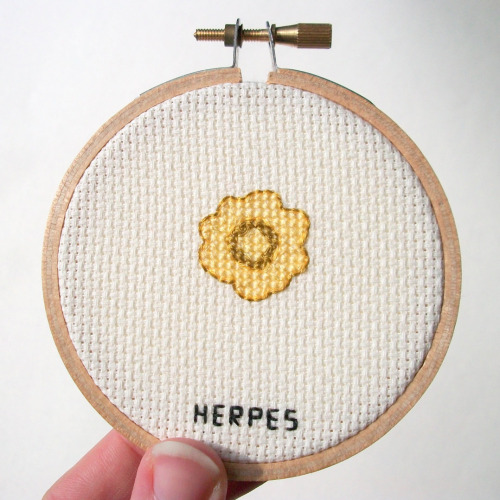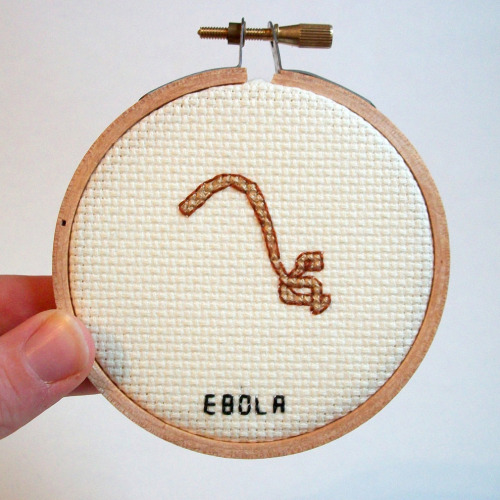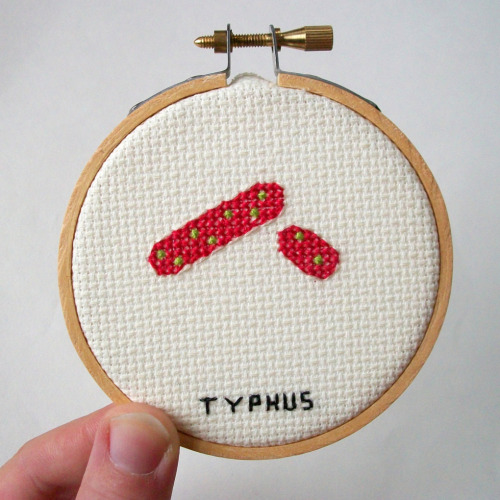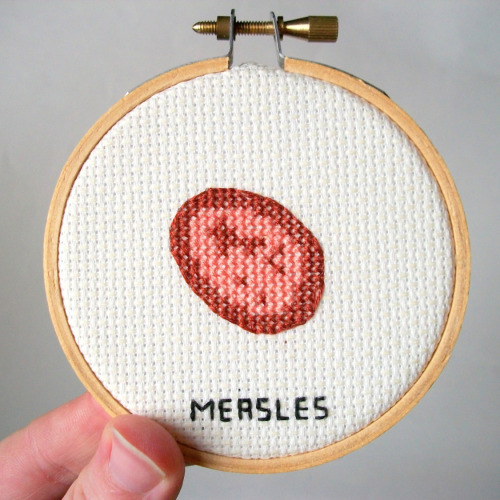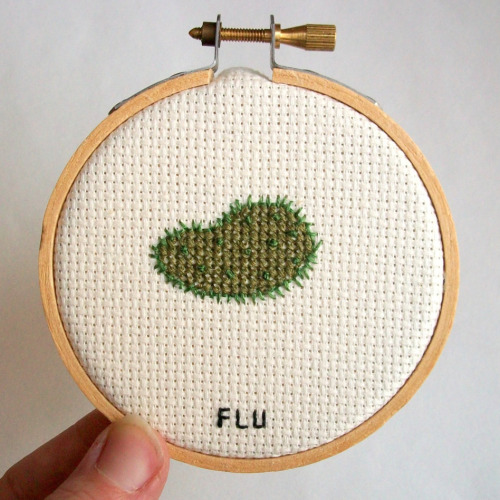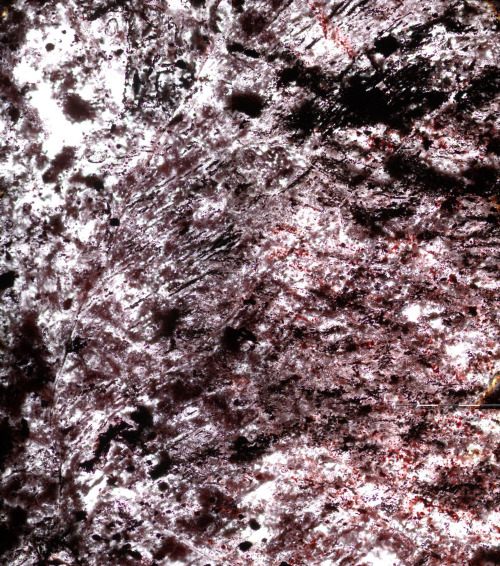#microbes
Water flea
A water flea.
For #LatinxHeritageMonth, we’re thrilled to highlight Dr. Ana María Porras Corredor (@AnaMaPorras), an assistant professor at @UFBME, @ifthenshecan ambassador, and fierce advocate for #InclusiveSciComm!
Originally from Colombia, Dr. Porras Corredor came to the US to follow a dream of being a biomedical engineer. After obtaining a BS, MS, & PhD in the field, her lab now focuses on using engineering to study how microbes cause diseases in humans.
She also actively works to share the benefits of microbes through her crocheted #sciart in English and Spanish online (@anaerobias ), through her teaching as a professor at @UFBME and through her outreach with Clubes de ciencia (@CdeC_col).
Dr. Porras Corredor is such a fierce advocate for multicultural/lingual communication that in addition to co-founding @LatinxInBME, the first @storycollider event hosted all in spanish was thanks to her efforts as an #IfThen ambassador. Thanks for all you do Dr. Porras Corredor!
.
PS: If you’d like to help support Dr. Porras Corredor (
@AnaMaporras
) and
@CdeC_Col
and/or crochet your own microbe, you can make a donation at http://bit.ly/ClubesGuajira! (Swipe photo)
.
.
.
#WomenInSTEM #LatinxInSTEM #LatinxInBME #BiomedicalEngineering #Microbes #CrochetArt #Crochet #Science
https://www.instagram.com/p/CUaftDzFWYs/?utm_medium=tumblr
Post link
Several years ago, snorkelers off the Greek island of Zakynthos were amazed to find what they thought were the remains of an ancient Greek civilization submerged in the shallow water. What appeared to be stone columns and column bases, so common to the Hellenic landscape, scattered the sea floor, giving the impression of ancient architecture taken over by the sea.
However,a recent paper published in Marine and Petroleum Geology explains that the column-like structures are not stone at all, but were created by microbes in a process that breaks down methane gas!
The methane moves up through faults in the Earth into the sediment that makes up the seabed. Here, bacteria in the sediment consume the methane and thus change the chemical makeup of the surrounding seawater. This causes dissolved minerals to precipitate out of the water and form a type of rock called dolomite, which cements the sediment and forms concretions. The concretions take the shape of columns and similar donut shapes because of the way the methane flows through the sentiment.
While not unheard of, concretion structures are uncommon in such shallow waters. Similar phenomena have been seen frequently in the North Sea and in fracking sites. Julian Andrews, the head researcher, reported to CNN that “these gas leaks are quite common” and that “the earth’s crust is quite a leaky material.” Andrews continues to explain that the Zakynthos site is notable for its “shallow setting.”
While the snorkeling tourists might be disappointed that they didn’t stumble across a real-life Atlantis, for those of us who love microbiology, this discovery is just as golden!
To read more, check out the full article.
Post link
It’s a regular Wednesday morning, and some of you reading this might be sitting in your office, sipping coffee, just trying to get through your morning workload.
You might be sitting in a cubicle, surrounded by coworkers, or you might have your own office, but we’re here to remind you that you’re never truly alone at work - we share our office chairs and keyboards with microbes, and breathe the same office air as them! Don’t take out your sanitizer just yet, because, after all, not allmicrobes are harmful! In fact, they are a big part of our environment.
We’ve all heard of microbiomes in the gut that are specific to the individual - but now there are reported, scientific findings that show that microbiomes also exist in the office. According to studies conducted by Gregory Caporaso and his team at Northern Arizona University, every office environment has a microbiome that’s specific to its location. The specificity is the result of varied external environments.
The study was conducted in nine offices across Flagstaff, San Dieog, and Toronto, all chosen for their varied climates. Collection plates were installed in offices in each of these cities, and the plates were covered in materials such as carpet, tile, and drywall to test for microbial differences across materials.
Researchers then discovered that there were no differences in bacterial communities across materials, but that their location in a particular room did matter. Overall, samples taken from offices in the same city were more similar to one another than samples from other cities. This is mostly a result of the external environment, such as climate, vegetation, and industry.
It remains to be discovered whether some microbiomes are making us unhealthier than others. However, we could potentially use this knowledge to make our environments healthier by engineering healthier microbiomes. This technology might sound like science fiction, but, then again, just 15 years ago, so did smartphones!
Read more about cities and their unique microbes here.
Post link
You may not know what a binturong looks like… but you probably know what it smells like. The binturong, or bearcat, of Southeast Asia smells distinctly like buttered popcorn! A new study from Duke on the chemical compound in this civit’s urine has determined that the scent’s source is 2-acetyl-1-pyrroline (or 2-AP)– the same compound that makes your mouth water in a movie theater.
Using gas chromatography-mass spectrometry, researchers were able to isolate and identify 29 chemical compounds in binturong urine. Since the animals pee while squatting, their feet and tails are often soaked, which leaves their distinctive aroma on both their bodies and in the branches and leaves of the trees they climb as a kind of scent trail.
What’s more, 2-AP was among the few compounds that lingered and became more dominant over time, a fact the researchers discovered when a rush airmail shipment of frozen binturong urine was delayed on a hot tarmac en route to co-author Thomas Goodwin of Hendrix College in Arkansas for analysis.
The remaining mystery is how they are able to form 2-AP at such low temperatures. In the popcorn popping process, for example, the compound is only released with high heat.
“If you were to make this compound, you would have to use temperatures above what most animals can achieve physiologically,” said Christine Drea, a professor of evolutionary anthropology at Duke who led the study. “How does this animal make a cooking smell, but without cooking?”
Read more on this delicious/disgusting mystery here!
Post link
Check out this time-lapse video that shows a superbug, once thought of as static or non-motile, exhibiting signs of active motility.
Scientists can prove, for the first time, that S. aureus may be able to move independently, which could have major implications for treating future infections caused by the once difficult-to-treat, antibiotic-resistant MRSA.
Finding life on Mars has captured the imagination of generations, but experts still aren’t sure what exactly we’re looking for. The Danakil Depression in Ethiopia, with a landscape of boiling pools of water and mounds of salt and sulfur that itself seems extraterrestrial, might offer some clues. Despite being one of the lowest, hottest and driest places on Earth, the region is host to extremophiles–– microbes that thrive in these inhospitable conditions.
Dr. Felipe Gómez Gómez of the Centro de Astrobiología in Madrid, who is working on isolating and studying these bacteria, believes learning to identify life in extreme environments here on Earth is the key to identifying any alien life that might be out there.
“What is life? What are the limits of life? Scientists don’t agree on what is life,” Dr. Gómez said. “If we find life on Mars, would we be able to recognize it? We don’t know.”
These organisms might also provide insight into how potential life-forms might survive in the sparse environment of Mars. From the article:
These simple organisms can survive with a “very small battery,” and were probably among the first bacteria on Earth, Dr. Gómez said. “That is what makes them so interesting from an astrobiological point of view.”
Organisms such as chemolithotrophs don’t require traditional means of sustenance like light and organic compounds and instead use inorganic compounds such as sulfide, hydrogen and ammonia as energy sources. Though they might be a far cry from little green men with antennae, they could offer us a more realistic idea of what to expect if and when we finally make “first contact”.
Read more at The New York Times here.
Post link
The Jefferson Memorial, originally built from smooth marble, has become pitted due to rain water over its 73 years. A biofilm has grown in those pits and taken over the outside of the building, leaving it black and dingy. Scientists are still figuring out the composition of the microbial invasion. It’s unclear at this point whether the microbes are eating the stone, though it is clearly growing at alarming rates. The Park Service says that the film also appears to be on the memorial amphitheater at Arlington National Cemetery, the Washington Monument and the Lincoln Memorial.
The film is actually a “multicultural” community of organisms living in the relatively harsh environment of the sun-blasted stone, said Federica Villa, a Milan-based microbiologist who has been studying the memorial’s surface. The black pigment is produced by the organisms to protect themselves from solar radiation, she said in an interview Tuesday.
But does the biofilm damage stone?
“We don’t know,” Villa said from Montana State University’s Center for Biofilm Engineering. “If you read the scientific literature, most of the scientists correlate the presence of a biofilm with deterioration.”
But she said her experiments have shown that biofilm may have a protective impact on stone.“To be honest, we have a lot of work to do,” she said.
Ten chemical treatments of biocides are currently being tested on the side of the memorial to determine the best route to clean the monument without harming the marble, as shown in the image above.
Post link
Infectious bacterial diseases and where to find them.
click here to download all 438 notes and study guides I made in med school
Post link
E. coli rarely form flagellae
The flu virus is round, not bean-shaped
Yeast grow a single bud at a time
Microbiology might be cute, but it’s cuter when you get it right.
Hi! Thanks for your note. I’m the stitcher who patterns and stitches these microbes, most often with input and images sent to me by scientists, medical professionals, lab techs, or pretty much anyone interested in microbiology. I’m not a scientist myself, but I do base my patterns on the microscopic images that are available to me, and I rely on experts to point out inaccuracies…while also trying to make sure that the microbes I stitch are unique and different enough from each other to be both recognizable and artistically interesting. (And sure, cute.)
Sometimes that means stitching the slightly more rare versions of microbes, I guess. So I’m not too worried about E. Coli rarely growing flagellae – particularly since I also stitch an E. Coli FTSZ-ring cross stitch, here: https://www.etsy.com/listing/113037127/e-coli-ftsz-ring-microbe-germ-cross
…which was commissioned by a customer whose father spent 20+ years studying E. Coli. She also gave him the one you see in this photoset as a gift.
Here’s the image I used for the original E. Coli: http://a.tgcdn.net/images/products/additional/carousel/bacteria-ecoli.jpg
This was the flu image I used to pattern and stitch the influenza virus you’re seeing here (also where the bird flu pattern came from): http://textbookofbacteriology.net/themicrobialworld/Influenza.html
Here’s the image I based the beer yeast on: http://blog.oregonlive.com/thebeerhere/2008/09/large_yeast.jpg
I freely admit that I picked the microbe from each photo that was most visually interesting and unique to my unscientific, crafter’s eye. If it helps, you might think of my work as less an indicator of the typical appearance of the average microbe for its type and more an artistic interpretation of some of the smaller ends of the bell curves of “what things really look like.” Just as you wouldn’t expect a painter to only paint the platonic ideal of a tree and complain if there were too many branches on the one she chose to paint instead, I’m not sure it’s fair to expect me to hold myself to a higher standard of normalcy than nature appears to.
These are more a set of thoughts on feminism, craft, science, germs, microscopic life and modern society, than they are a science textbook.
But if my interpretations of the images I’m sharing here are flawed, I welcome correction.
Post link

(Image: Artist’s impression of NASA’s Perseverance rover on Mars)
Today NASA’s Perseverance rover landed on Mars. I don’t usually talk astronomy on this blog, but this time it’s relevant because—as you might have read—Perseverance is more or less the first palaeontologist on Mars!
Let me explain.
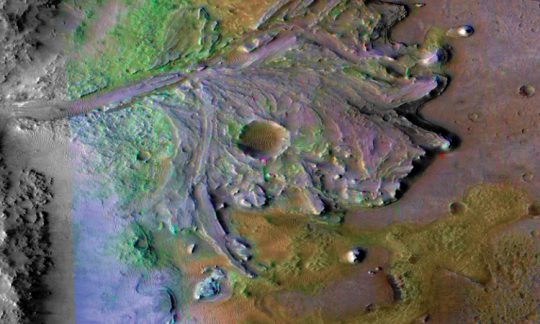
(Image: Satellite topography map of Jezero Crater, the site where Perseverance landed)
The site where Perseverance is landing, Jezero Crater, is a meteor impact crater near Mars’s Equator (say that 10 times fast!). It has evidence of a delta—the geomorphic feature that occurs when running water enters a large body of water. Orbital analyses also suggest it’s filled with carbonate rock—the kind that tend to deposit at the bottom of bodies of water.
Jezero Crater is not filled with water today. But the evidence strongly suggests it once was. If we’re going to find evidence of life on Mars, this is a good place to start looking.
Microbial fossils
When you think of fossils, most people think of giant T. rex skeletons, or frozen woolly mammoths, or neanderthal skulls. Maybe you’ve been around the block a bit, and you think about corals, or plant fossils, or tiny fossil shells. But some of the most common and important fossils on Earth are even tinier. Microbial fossils are commonly made by bacteria, archaea, and the like.
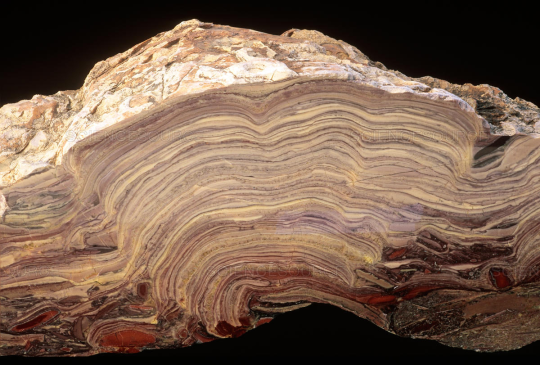
(Image: A cross-section of a stromatolite fossil, showing the multiple layers)
Some of the earliest fossils on earth are called stromatolites. They occur when bacterial colonies grow together in a mat—then, over time, sediment deposits over the colony, and the bacteria form another layer on top of the previous layer. Over time, many layers can be formed.
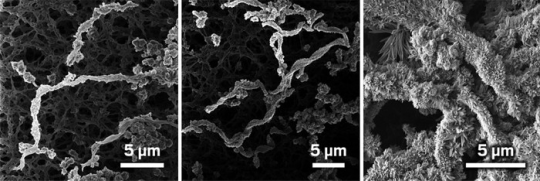
(Image: Helium Ion Microscopy image of iron oxide filaments formed by bacteria)
Although we breathe in oxygen and breathe out carbon dioxide, many microbes are not quite so restricted, and can breathe anything from sulphur to iron to methane or ammonia. When they do this, they often leave behind solid waste products, such as the above iron oxide filaments, that give away their presence. We can tell these apart from normal minerals in a number of ways, including by the relative proportions of different isotopes in them.
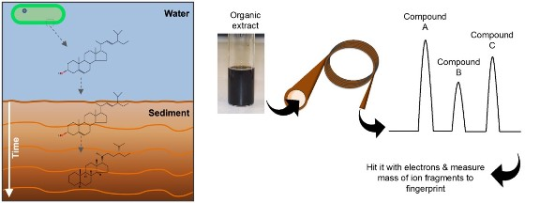
(Image: Schematic digram showing how molecular fossils form and are studied)
However, some of the most important fossils are molecular fossils. Living organisms produce a variety of different organic molecules; even long after the bodies of these organisms decay, those molecules can stay behind in an altered form for millions or even billions of years. If we’re looking for evidence of life on Mars, this might be our best bet.
Enter Perseverance

(Image: Diagram of Perseverance rover showing different instruments)
The Perseverance rover is overall similar in design to the Curiosity rover that landed in 2012, but there are some key differences—and most relevant here is that it’s a geological powerhouse. It’s got a number of instruments designed to carry out detailed geologic investigations:
- RIMFAX is a ground-penetrating Radar unit. Like normal Radar, it works by sending radio waves into the ground; different materials affect the radio waves differently, as do transitions between different materials. This will allow us to, for the first time, study the geology of Mars below the surface to get an idea of what has been going on down there.
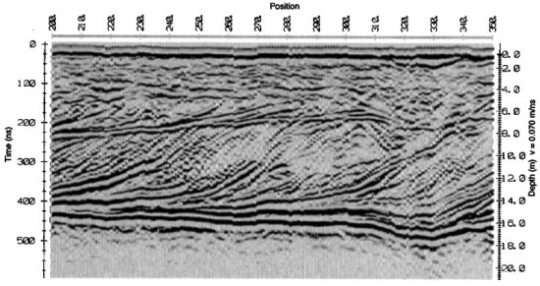
(Image: This is the kind of result produced by ground-penetrating radar—a rough image of the stratigraphy below the surface.)
- PIXL(Planetary Instrument for X-ray Lithochemistry) shoots x-rays at samples and examines how they fluoresce in reaction. This allows for the detection of the elemental composition of a sample—helping us better understand the geology of the area, and potentially detect signatures of life.
- SuperCam is a multi-function laser spectrometer that uses four different spectroscopy methods to examine the composition of samples. They all work in similar ways—essentially, different molecules react to laser stimulation differently, and different amounts of energy are required to make different molecules vibrate. The way that these molecules react can help us identify their composition, and the hope is that this may allow us to detect molecular fossils (these methods allow us to detect molecular fossils on Earth!)
- SHERLOC (Scanning Habitable Environments with Raman & Luminescence for Organics & Chemicals) is another spectroscopic instrument—this one, however, is more precise, and optimised for detecting trace biosignatures in samples. It works similar to the above, using an ultraviolet laser to scan a 7 × 7 mm zone for evidence of organic compounds.
In addition to studying samples in situ, Perseverance will package small samples and leave them behind on Mars. A planned future mission will collect these packaged samples and launch them into space, where an orbiter will collect them and—hopefully—return them to Earth. This would be the first time that samples have ever been recovered from Mars, and would go a long way in increasing our understanding of the Martian environment and geology.
There’s no way of knowing yet what Perseverance will find—but even the fact that a robot palaeontologist is on Mars is incredibly exciting. Here’s to many years of discovery!
Diverse Microbial Life Forms Existed At Least 3.75 Billion Years Ago, Study Confirms
http://www.sci-news.com/paleontology/nuvvuagittuq-fossils-10712.html
Post link
Feed Cannabis Plants for $5 with these Organic Plant Fertilizers, Nutrients ,and Foods
I will be Showing You some of the Cheapest Organic ,and NON GMO Plant Supplements that, You can Make Yourself, From Your Own Pantry, All for About $5 total.
Post link



